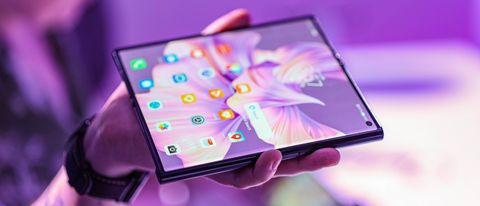Early Verdict
Huawei's upgrade to the original Mate Xs does something unique – it folds the wrong (or right) way – depending on your opinion. As for how it fares in the real world, it needs to be good – after all, it costs a huge amount of money. In the flesh, we can't help but be impressed by how thin and light it is – a real design showcase for the brand. Now it's a waiting game to see if it hits our shores.
Pros
- +
Incredibly thin at its slimmest point
- +
Larger folding screen than competition
- +
Improved latch mechanism vs original
Cons
- -
Seriously expensive, even for a foldable
- -
Last-gen Snapdragon chipset
- -
No 5G in Western edition
Why you can trust TechRadar
Huawei pioneered a breed of foldable that was thought to have been retired until we found out about the Mate Xs 2. The original Huawei Mate X, followed by the Huawei Mate Xs, is a phone series that folds the opposite way to the popular Samsung Galaxy Z Fold 3, placing the folding, wraparound screen on the front of the closed phone.
This unique, wraparound foldable design opens up a wealth of advantages, showcased by the Mate Xs 2's predecessor. These include a thinner body, a larger tablet screen, and a comfortable front display when in smartphone mode. That's versus the hyper-tall 25:9 cover screen on the Galaxy Z Fold 2 and Z Fold 3 that's super-narrow.
Despite its advantages, however, there's no getting around the fact that an outer folding screen is more susceptible to damage than an inner-folding screen. Huawei's phones have also been plagued by limitations in recent years – no Google services or 5G, and the Mate Xs series has been reliably more expensive than the Z Fold series.
With all this in mind, can Huawei's new, improved, hardier foldable convince category skeptics (and Huawei skeptics alike) that the brand is really pushing the envelope in a meaningful way, or does it all feel like expensive filler from a brand that's struggling to keep a footing in mobile, despite excelling in other product categories?
Huawei Mate Xs 2 price and availability
Launch timings for the Huawei Mate Xs 2 are yet to be confirmed, but we do know it's coming to Europe in June or shortly after – specific details are yet to be confirmed.
Set to cost around €1,999 – roughly £1,700 / $2,710 / AUS $3,000, it's one of the priciest foldables we've seen to date and demonstrates Huawei bucking the trend toward more affordable folding phones seen from Samsung.
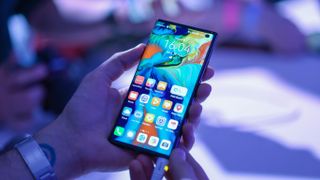
Design and display
The Huawei Mate Xs 2 is thin unfolded – just 5.4mm across most of its body, with a wedge at the end where the brains of the phone live. That's even thinner than the already waif-like, 6.4mm Galaxy Z Fold 3.
The main design improvement we noticed as soon as we started playing with it was the clasp. It's now much easier to lock the phone closed – there's no big 'click' when you press it into place as on the Mate Xs, just a smooth, unnoticeable mechanism that secures it shut.
The Mate Xs 2 still bounces back when unlatched from closed to open, and so doesn't offer the range of folding angles available on Samsung's foldables. Its Falcon Wing hinge isn't designed to be half-open.
The big flexible display is both the tablet screen and the phone screen, which means when in phone mode, the back of the phone is partly screen. This is handy in some instances – you can fire up a preview when in the camera app so your subject can see what you're shooting. That said, it's also a point of weakness, after all, foldable screens are historically fragile.



On the thick strip on the right side of the Xs 2, a USB-C port for charging lives at the base, a volume rocker and power button which doubles up as a fingerprint scanner along the side, and the cameras on the back.
The phone's back, on the reverse of the screen, is a cross-hatch textured fiberglass material that's both light and durable according to Huawei, and the rest of the frame is free from buttons and ports.
As for the display, this is where Huawei claims it has upped its durability. The screen benefits from a four-layer system that protects it from dings, and it looks and feels more like glass than the more warped Mate Xs.
The screen measures 7.8 inches when open, and 6.5 inches when closed, and bests the Z Fold 3 when it comes to size and clarity. The fact you're swiping the same display whether in phone or tablet mode means you get the same screen experience whichever way you're using the phone. That means a 120Hz OLED screen with a pixel density of 424 pixels per inch.
In the flesh, it looks seriously zingy and colorful, with 10-bit visuals and deep, OLED blacks. There's a noticeable bump down the middle, but it's less pronounced than the crease of the Galaxy Z Fold 3.
Performance and software
Unlike Huawei's tablets and smartwatches, the Mate Xs 2 and its entire phone line runs EMUI, Huawei's layer over the top of Android.
Just like other Huawei phones, the Mate Xs 2 lacks access to the Google Play Store and Google Play services, however, it benefits from some of Huawei's enhancements to help eke out more from its large, unfolding screen. It's easy to fire up multi-tasking, with both split-screen apps and floating window apps available.
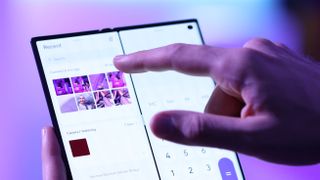
Huawei tries to take the sting off the missing Play Store by investing heavily in its AppGallery, which integrates a feature called Petal Search. This gives you access to most of the apps you'll probably need, with the likes of Disney Plus, Netflix, and Instagram available.
As for the phone's internals, it's using a Qualcomm Snapdragon 888 4G – a 2021 flagship processor with 5G disabled. This dialed back power and connectivity puts the Mate Xs 2 on the back foot from a performance point of view, and the lack of 5G (which is down to sanctions placed on Huawei) is another tough pill to swallow, given the phone's price.
As for the battery, it's a 4,600mAh cell, with the phone charging at up to 66W. Unlike the Z Fold 3, Huawei's folding flagship misses out on wireless charging, however, its slightly larger battery is a boon.
Camera
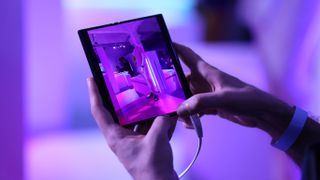
Huawei's known for its great camera tech, and a 50MP main camera with an f/1.8 lens leads the charge for the Mate Xs 2. There's also an 8MP telephoto camera with a 3.4x optical zoom, matched with an f/2.4 lens, and a 13MP ultra-wide camera with an f/2.2 lens.
Most notable is the fact Huawei has added a punch-hole selfie camera to the phone's display. On the one hand, this interrupts what was an expansive, all-screen design on the last-gen Mate Xs. On the other, as a phone, it should all work a lot better – you won't have to open it up for video calls or to take a selfie.
Early verdict
It's always difficult summarising Huawei kit. The tech in the Mate Xs – its screen, the design and the engineering that brings it all together is exceptional. But the fact Huawei's not able to use Google services or 5G in its phones is a serious blow.
The Mate Xs 2 is also super expensive. So, while it's the most exciting smartphone design of 2022 so far, and no doubt a powerful, capable phone likely to have strong cameras and a smooth, optimized interface, it will still be an incredibly tough sell.
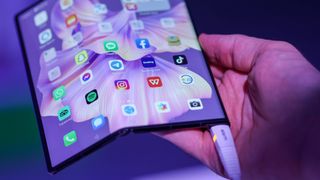
This all means the Mate Xs 2 is a mighty demonstration of Huawei's engineering excellence and resilience. What it probably isn't, however, is your next smartphone (unless you're very, very rich).
Basil Kronfli is the Head of content at Make Honey and freelance technology journalist. He is an experienced writer and producer and is skilled in video production, and runs the technology YouTube channel TechEdit.
What is a hands on review?
Hands on reviews' are a journalist's first impressions of a piece of kit based on spending some time with it. It may be just a few moments, or a few hours. The important thing is we have been able to play with it ourselves and can give you some sense of what it's like to use, even if it's only an embryonic view. For more information, see TechRadar's Reviews Guarantee.
